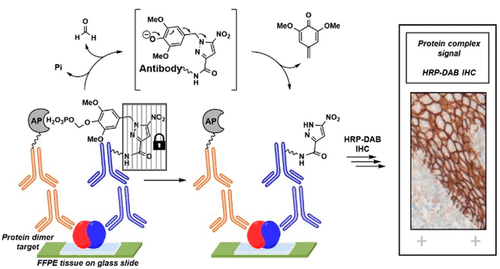当前位置:
X-MOL 学术
›
Bioconjugate Chem.
›
论文详情
Our official English website, www.x-mol.net, welcomes your
feedback! (Note: you will need to create a separate account there.)
Fully Automated Protein Proximity Assay in Formalin-Fixed, Paraffin-Embedded Tissue Using Caged Haptens.
Bioconjugate Chemistry ( IF 4.0 ) Pub Date : 2020-05-12 , DOI: 10.1021/acs.bioconjchem.0c00193 Nathan W Polaske 1 , Brian D Kelly 1 , Matthew A Smith 2 , Eric B Haura 2 , Yuri Y Belosludtsev 1
Bioconjugate Chemistry ( IF 4.0 ) Pub Date : 2020-05-12 , DOI: 10.1021/acs.bioconjchem.0c00193 Nathan W Polaske 1 , Brian D Kelly 1 , Matthew A Smith 2 , Eric B Haura 2 , Yuri Y Belosludtsev 1
Affiliation

|
The ability to interrogate for the presence and distribution of protein–protein complexes (PPCs) is of high importance for the advancement of diagnostic capabilities such as determining therapeutic effects in the context of pharmaceutical development. Herein, we report a novel assay for detecting and visualizing PPCs on formalin-fixed, paraffin-embedded material using a caged hapten. To this end, we synthetically modified a nitropyrazole hapten with an alkaline phosphatase (AP)-responsive self-immolative caging group. The AP-labile caging group abrogates antibody binding; however, upon exposure to AP, the native hapten is regenerated. These caged haptens were applied in a proximity assay format by the use of a first antibody labeled with caged haptens that can be uncaged by AP conjugated to the second antibody. Only when the two epitopes of interest are in close proximity to one another will the AP interact with the caged hapten and uncage it. The native hapten, which represents the population of PPCs, was then visualized by an anti-hapten antibody conjugated to horseradish peroxidase, followed by diaminobenzidine detection. We provide proof of concept for the detection of protein proximity pairs (β-catenin–E-cadherin and EGFR–GRB2), and confirm assay specificity through technical controls involving reagent omission experiments, and biologically by treatment with small-molecule kinase inhibitors that interrupt kinase–adaptor complexes.
中文翻译:

使用笼罩半胱氨酸在福尔马林固定,石蜡包埋的组织中进行全自动蛋白质邻近测定。
询问蛋白质-蛋白质复合物(PPC)的存在和分布的能力对于提高诊断能力(例如在药物开发过程中确定治疗效果)非常重要。在这里,我们报告了一种新颖的检测方法,用于使用笼状半抗原检测和可视化福尔马林固定,石蜡包埋的材料上的PPC。为此,我们用碱性磷酸酶(AP)响应的自消灭笼养组合成了硝基吡唑半抗原。AP不稳定的笼基基团消除了抗体的结合;但是,暴露于AP后,天然半抗原会再生。通过使用标记有笼状半抗原的第一抗体将这些笼状半抗原应用在邻近测定法中,该抗体可以被偶联至第二抗体的AP取消笼状。仅当两个感兴趣的表位彼此紧邻时,AP才会与笼中的半抗原相互作用并解开它们。然后,通过与辣根过氧化物酶偶联的抗半抗原抗体观察代表PPC种群的天然半抗原,然后检测二氨基联苯胺。我们提供了用于检测蛋白质邻近对(β-catenin–E-cadherin和EGFR–GRB2)的概念验证,并通过涉及试剂遗漏实验的技术控制和通过使用可中断干扰的小分子激酶抑制剂进行治疗来确认测定的特异性激酶-适配器复合物。然后通过与辣根过氧化物酶偶联的抗半抗原抗体进行可视化,然后检测二氨基联苯胺。我们为检测蛋白质邻近对(β-catenin–E-cadherin和EGFR–GRB2)提供了概念验证,并通过涉及试剂遗漏实验的技术控制来确定测定的特异性,并通过使用可中断该反应的小分子激酶抑制剂进行生物学处理激酶-适配器复合物。然后通过与辣根过氧化物酶偶联的抗半抗原抗体进行可视化,然后检测二氨基联苯胺。我们为检测蛋白质邻近对(β-catenin–E-cadherin和EGFR–GRB2)提供了概念验证,并通过涉及试剂遗漏实验的技术控制来确定测定的特异性,并通过使用可中断该反应的小分子激酶抑制剂进行生物学处理激酶-适配器复合物。
更新日期:2020-05-12
中文翻译:

使用笼罩半胱氨酸在福尔马林固定,石蜡包埋的组织中进行全自动蛋白质邻近测定。
询问蛋白质-蛋白质复合物(PPC)的存在和分布的能力对于提高诊断能力(例如在药物开发过程中确定治疗效果)非常重要。在这里,我们报告了一种新颖的检测方法,用于使用笼状半抗原检测和可视化福尔马林固定,石蜡包埋的材料上的PPC。为此,我们用碱性磷酸酶(AP)响应的自消灭笼养组合成了硝基吡唑半抗原。AP不稳定的笼基基团消除了抗体的结合;但是,暴露于AP后,天然半抗原会再生。通过使用标记有笼状半抗原的第一抗体将这些笼状半抗原应用在邻近测定法中,该抗体可以被偶联至第二抗体的AP取消笼状。仅当两个感兴趣的表位彼此紧邻时,AP才会与笼中的半抗原相互作用并解开它们。然后,通过与辣根过氧化物酶偶联的抗半抗原抗体观察代表PPC种群的天然半抗原,然后检测二氨基联苯胺。我们提供了用于检测蛋白质邻近对(β-catenin–E-cadherin和EGFR–GRB2)的概念验证,并通过涉及试剂遗漏实验的技术控制和通过使用可中断干扰的小分子激酶抑制剂进行治疗来确认测定的特异性激酶-适配器复合物。然后通过与辣根过氧化物酶偶联的抗半抗原抗体进行可视化,然后检测二氨基联苯胺。我们为检测蛋白质邻近对(β-catenin–E-cadherin和EGFR–GRB2)提供了概念验证,并通过涉及试剂遗漏实验的技术控制来确定测定的特异性,并通过使用可中断该反应的小分子激酶抑制剂进行生物学处理激酶-适配器复合物。然后通过与辣根过氧化物酶偶联的抗半抗原抗体进行可视化,然后检测二氨基联苯胺。我们为检测蛋白质邻近对(β-catenin–E-cadherin和EGFR–GRB2)提供了概念验证,并通过涉及试剂遗漏实验的技术控制来确定测定的特异性,并通过使用可中断该反应的小分子激酶抑制剂进行生物学处理激酶-适配器复合物。











































 京公网安备 11010802027423号
京公网安备 11010802027423号